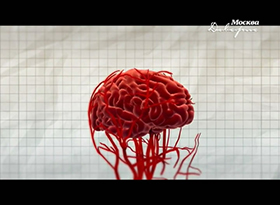НЕКОТОРЫЕ ПУБЛИКАЦИИ
Results of Microsurgical Treatment of Large and Giant ICA Aneurysms Using the Retrograde Suction Decompression (RSD) Technique: Series of 92 Patients
BACKGROUND: Microsurgical treatment of large and giant paraclinoid internal carotid artery (ICA) aneurysms often requires the use of the retrograde suction decompression (RSD) technique to facilitate clipping. Surgical results, functional outcomes at discharge, and technique limitations based on single institution series are presented.
MATERIALS AND METHODS: Between 1996 and 2009, eighty-three consecutive patients (19 to 68 years, mean 45.5 9.9 years), predominantly women (69 women and 14 men) with large (23 patients, 27.7%) or giant (60 patients, 72.3%) paraclinoid aneurysms were surgically treated with the RSD technique performed by the neck route (62 patients, 74.4%) or later on, by endovascular means (21 patients, 25.3%). Patients were admitted after hemorrhage (48 patients, 57.9%), pseudotumor course (28 patients, 33.7%), mixed symptoms (5 patients, 6%), or asymptomatic (2 patients, 2.4%).
RESULTS: In most RSD surgeries (90.4%) aneurysms were successfully excluded: neck was clipped in 57 patients (68.7%) or clipping with ICA reconstruction was achieved in 18 patients (21.7%). In six patients aneurysms were wrapped with glue (7.2%), trapped in one patient (1.2%), and in one patient, ICA balloon deconstruction was performed (1.2%). Good or excellent results (Glasgow Outcome Scale scores 4-5) at discharge were achieved in 69 patients (83.1%), 11 patients (13.3%) remained severely disabled (Glasgow Outcome Scale 3), and 3 patients died (3.6%).
CONCLUSIONS: Surgical clipping with the RSD method remains a treatment of choice with acceptable outcomes for patients not amenable for endovascular treatment.
Shalva S. Eliava, Yuri M. Filatov, Sergei B. Yakovlev, Oleg D. Shekhtman, Ali S. Kheireddin, Ilya A. Sazonov, Olga B. Sazonova, Dmitry N. Okishev
- Удаление каверномы глубинных отделов правого полушария
- Клипирование de novo образованной аневризмы левой СМА
- Клипирование крупной частично тромбированной аневризмы
- Удаление каверномы в сочетании с амигдало-гиппокампэктомией
- Иссечение АВМ после частичной эмболизации композицией onyx
- Клипирование гигантской аневризмы СМА с применением методики ВАК






